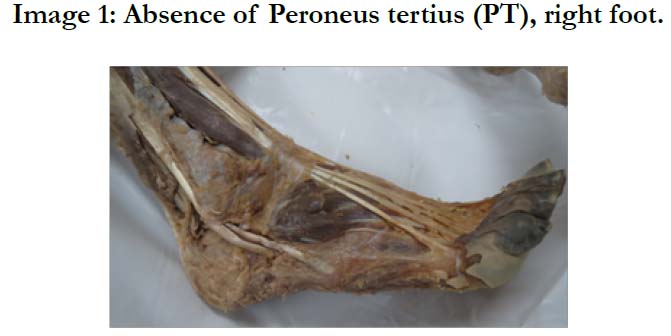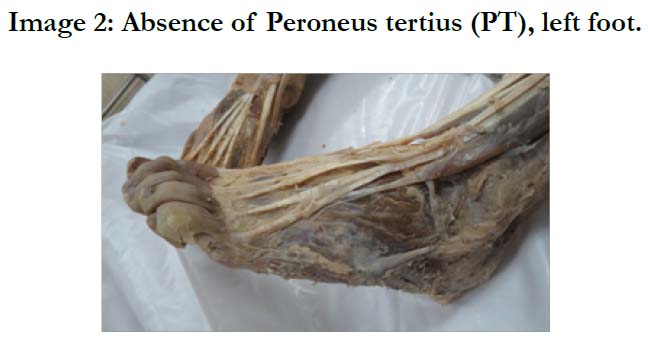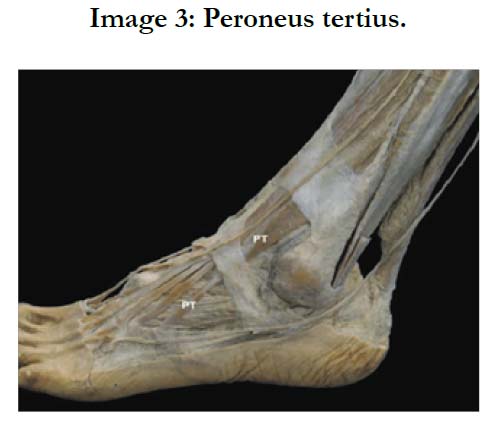Case of Bilateral Absence of the Fibularis (Peroneus) Tertius Muscle in our Anatomy Laboratory
Ismael Lugo MSI1, Fabiola Morell MSI1, FabianaHimet MSI1, Miguel Sugranyes MS2, Jorge Pérez MD3*
1 Medical Student, Anatomy Department, San Juan Bautista School of Medicine, Caguas, Puerto Rico.
2 Professor, Anatomy Department, San Juan Bautista School of Medicine, Caguas, Puerto Rico.
3 Chair, Anatomy Department, San Juan Bautista School of Medicine, Caguas, Puerto Rico.
*Corresponding Author
Jorge Pérez, MD,
Anatomy Department, San Juan Bautista School of Medicine, Caguas, Puerto Rico.
E-mail: jperez@sanjuanbautista.edu
Tel: (787) 743-3483 ext. 248
Received: September 11, 2023; Accepted: September 27, 2023; Published: January 27, 2024
Citation: Ismael Lugo MSI, Fabiola Morell MSI, FabianaHimet MSI, Miguel Sugranyes MS, Jorge Pérez MD. Case of Bilateral Absence of the Fibularis (Peroneus) Tertius Muscle
in our Anatomy Laboratory. Int J Anat Appl Physiol. 2024;10(1):228-229.
Copyright: Jorge Pérez MD@2024. This is an open-access article distributed under the terms of the Creative Commons Attribution License, which permits unrestricted use, distribution and reproduction in any medium, provided the original author and source are credited.
Abstract
The peroneus tertius muscle (PT) has been an underestimated muscle in the medical community due to its unclear clinical relevance. It seems that this muscle varies in frequency depending on the region of the world. Up to 2022, the database exhibited no literature on bilateral or unilateral absence of the peroneus tertius in the Puerto Rican population. This finding in 2019 of bilateral absence of PT in an 80 year old male cadaver, represents the first documented case in Puerto Rico. Reporting the variations of such a muscle in different world populations is crucial to gain greater understanding of its function as well as more about its clinical and anthropological significance.
2.Introduction
3.Conclusion
4.References
Keywords
Peroneus Tertius; FibularisTertius.
Background
The peroneus tertius (PT), also known as the fibularistertius (FT),
is a muscle of the lower extremities that lies proximal to the extensor
digitorum longus (EDL) and inserts at the fifth metatarsal.
The morphology of this muscle may vary with insertion in
the fourth metatarsal bone as well.[1] In regard to its anatomical
function, the role of the PT in walking and posture is still being
debated even though its function is to assist in dorsiflexion and
foot eversion. No significant advantage has been found in individuals
with the PT in contrast to those without. Interestingly,
other accessory muscles have been present when the peroneus
tertius is absent. In a study where 7 cases displayed different accessory
muscles, 5 presented fibularisdigitiminimi tendon inserted
in the fifth metatarsal and 2 presented fibularisquartus muscle
and tendon inserting in the 5th metatarsal.[2] The study demonstrates
that the extent of anatomical diversity is broader with the
presence or absence of this muscle. Different studies have been
conducted to determine population frequencies of PT and morphological
variations. However, no case has been reported in the
Puerto Rican population, which raises the inquiry about whether
its lack of report is due to not noticing its absence or because it
was in fact absent at all.
The PT has shown variable prevalence in different populations
in the world where it has been reported to be missing in different
human populations. A translational research study was conducted
to analyze the prevalence of the PT muscle in five Arab populations
and explore the correlation between the presence or absence
of the PT muscle and ankle injury.[3] The clinical study determined
that the prevalence of the PT in three Asian countries was
observed in 42% in Bahrain, 38.5% in Saudi Arabia, and 41.2% in
Kuwait. For two North African populations, the prevalence was
67.7% in Tunisians and 52.8% in Egyptians.[3] Out of the five
countries, all presented with right side prevalence except for Bahrain,
which showed bilateral prevalence. The authors concluded
that although the presence of the PT was variable among all five
populations studied, there was a positive correlation between its
presence and ankle injury. It also provides a large sample (N =
1,248) and a comparison between five different populations.
Another study of populations located geographically closer to
Puerto Rico reported cadaver frequencies from Bolivia, Brazil and
Chile. With frequencies of 100%, 2 studies for Brazil 92% and
97%, and 51% respectively. [4] From an evolutionary perspective,
the data from other countries is critical for an anthropological examination. If more data regarding the absence of the PT muscle
in the Puerto Rican population can be gathered, we can examine
if there are any correlations with ankle injuries and this muscle. In
addition, we can contribute to the chronicling of the anatomical
variations of our species across time and geographic locations.
In order to make deductions about its role, more documentation
of its prevalence is required. Studies regarding the prevalence of
PT in the Puerto Rican population could assist in further understanding
its significance and the genetic variations it may carry
while present or absent.
Case Presentation
During routine cadaveric dissection in the Anatomy laboratory of
the San Juan Bautista School of Medicine in October 2019, one
cadaver showed a bilateral absence of the PT muscle. The variation
was found in the right and left anterior compartments of the
legs. The subject was identified as an approximately 80 year old
Puerto Rican male with a bilateral absence of the PT muscle. Image
1 is a photograph of the right foot from the cadaver reported.
Image 2 shows a photograph of the left leg of the same cadaver.
Image 2 shows the anatomical relation the PT has with other
structures of the leg, the PT is highlighted in neon green. No
other anatomical structures appeared to be missing in the cadaver.
Conclusion
There are no previous reports on the absence of the peroneus
tertius in a cadaver or live patient of Puerto Rican descent. Although
we don’t disregard the possibility that there may be more
subjects with the absence, we acknowledge that to our understanding
the data has not been collected. Therefore, this would
be the first case report on the island with a bilateral absence of
PT. This muscle has been underestimated, which accounts for few
studies exploring its anatomical and clinical relevance and debates
continue regarding its significance.
Thus, PT should continue to be studied in order to understand
the history and future evolution of this muscle. The contribution
of this case report could support the database on future studies
of the PT and its anatomical variations in cadavers or living patients
in Puerto Rico.
References
- Afroze MKH, Muralidharan S, Ebenezer JL, Muthusamy S. Morphological Variations of Peroneus Tertius: A Cadaveric Study with Anatomical and Clinical Consideration. Medeni Med J. 2020;35(4):324-329. PubMed PMID: 33717625.
- Yammine K, Eric M. The Fibularis (Peroneus) Tertius Muscle in Humans: A Meta-Analysis of Anatomical Studies with Clinical and Evolutionary Implications. Biomed Res Int. 2017;2017:6021707. PubMed PMID: 28596965.
- Joshi SD, Joshi SS, Athavale SA. Morphology of peroneus tertius muscle. Clin Anat. 2006 Oct;19(7):611-4. PubMed PMID: 16317742.
- Salem AH, Kader GA, Almallah AA, Hussein HH, Badie AA, Behbehani N, et al. Variations of peroneus tertius muscle in five Arab populations: A clinical study. Transl Res Anat. 2018 Nov 1;13:1-6.











